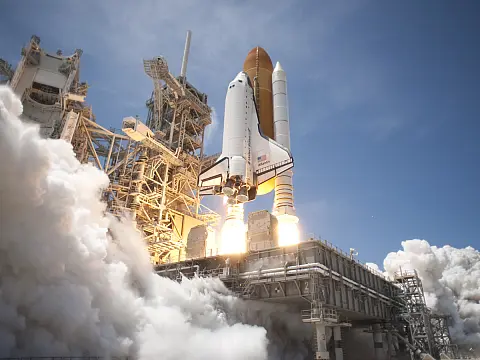Top 5 Space Exploration Breakthroughs of 20142014 has seen incredible space exploration breakthroughs like discovery of exoplanets and successfully landing the Mars Curiosity Rover.
2014 has been certainly an exceptional year for space exploration breakthroughs with some exceptional discoveries. Here's a summary of the top five discoveries and ground-breaking forays made in space this year.
Space Exploration Breakthrough #1 - First probe landing on a comet
Our first space exploration breakthrough is the first probe touchdown on a comet. On 12th November, 10 years after departing from Earth, the European Space Agency (ESA) lander "Philae" was the first probe to land on a comet. Philae left its spacecraft, Rosetta, and landed on comet 67P/Churyumov-Gerasimenko. Rosetta captured the first image of Philae landing at the comet on its navigation camera.
With its own official Twitter account, Philae has been able to keep in touch with us about its first-hand experience at the comet. After getting its feet on the ground, the lander tweeted the first image of its new home, a site the world had been waiting for.
Space Exploration Breakthrough #2 - Launch of the Orion Space Capsule
Our second space exploration breakthrough is that for the first time in a generation, NASA is building a brand new human spacecraft that will herald a new era of space exploration. NASA's Orion spacecraft is constructed to take humans farther than they have ever gone before. Orion will serve as the exploration vehicle that will carry the team to space, supply emergency abort capability, sustain the crew through space travel, and provide safe re-entry from deep space return velocities.
On the morning of 4th December, the Orion space capsule lifted off from Cape Canaveral Air Force Station Florida. Orion travelled two times through the Van Allen belt where it experienced high periods of radiation and reached an altitude of 3,600 miles above Earth. Orion additionally hit speeds of 20,000 mph and weathered temperatures approaching 4,000 degrees Fahrenheit as it entered Earth's atmosphere. Four and a half hours later the capsule re-entered the Earth's atmosphere and landed safely in the Pacific Ocean.
Space Exploration Breakthrough #3 - Curiosity rover finds organic molecules on Mars
NASA's Mars rover Curiosity made its first historical detection of organic molecules, that may well be the product of past or present life on the Red Planet. This discovery signifies that Mars may have had conditions favourable to hosting life.
The rover measured a spike in levels of the organic chemical methane within the local atmosphere of its research site. Additionally, Curiosity detected different organic molecules in drill samples from a mudstone that once sat at the bottom of the lake that filled Gale crater in Mars' ancient past.
Methane has in the past been detected within the Martian environment using Earth-based telescopes and orbital missions on the red planet. However, methane levels measured by Curiosity at Gale Crater have shown only a small fraction of methane in the air.
The new measurements showed a tenfold increase in local methane levels. The methane was short-lived and lowered to previous levels shortly after it appeared.
This temporary building up in methane - sharply up and then back down - tells us there must be some relatively localized source. There are many conceivable sources, biological or non-biological, reminiscent of the interaction of water and rock. Sushil Atreya of the University of Michigan, in a recent press release from NASA JPL
Methane is essential because it is an organic molecule frequently produced by life on Earth. However, methane is not evidence of life as it can also be produced by many various processes that don't involve living organisms. Even so, the finding proves that present-day Mars is an active world.
Space Exploration Breakthrough #4 - The First Earth-Sized, Habitable Zone Planet
In April 2014, scientists announced the discovery of Kepler-186f, a faraway planet that is in all probability the most Earth-like yet discovered.
Using NASA's Kepler Space Telescope, astronomers came upon the first Earth-size planet orbiting a star within the habitable zone - the range of distance from a star where liquid water might pool on the surface of an orbiting planet. The discovery of Kepler-186f confirms that planets on the scale of Earth exist within the habitable zone of stars other than our sun. While planets have in the past been discovered within the habitable zone, they are all no less than 40 per cent larger in size than Earth and working out their makeup is challenging. Kepler-186f is more reminiscent of Earth. Although the dimensions of Kepler-186f are known, their mass and composition aren't. Previous research, however, suggests that a planet the size of Kepler-186f is likely to be rocky.
Space Exploration Breakthrough #5 - Astronauts Print First 3-D Object in Space
NASA and officials with Made in Space Inc., the company that worked with NASA to design, construct and test the 3D printer, said the process may change how the ISS crews get replacement tools and parts. This is a very important step forward as specialist equipment is often required on board the space station. Now they can be "beamed" aboard and printed as an alternative to being despatched using rockets. The technology will also be important for longer travels to Mars.
The first printed object was a simple plaque reading "Made in Space NASA". Later parts include a 3d printed ratchet wrench.
The first items built in space will likely be returned to Earth in 2015 for detailed analysis to verify that the 3D printing process works the same in microgravity as it does on Earth, NASA said.














